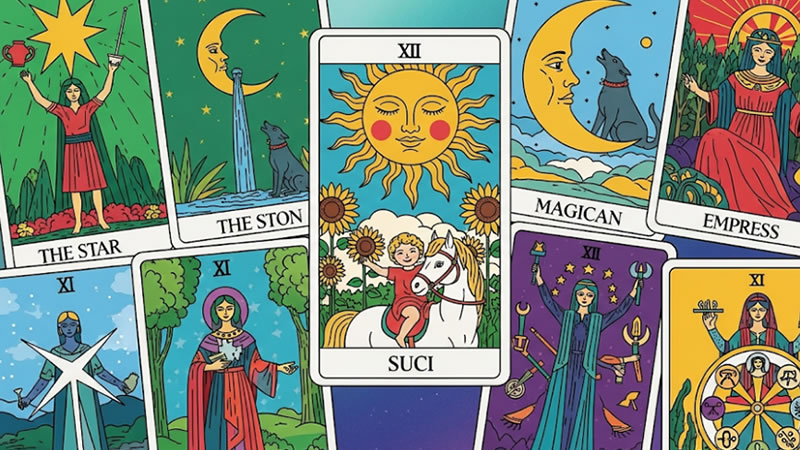The Historical Roots of Tarot de Marseille
The Tarot de Marseille represents one of the oldest and most influential tarot traditions in Western esotericism. Originating in 15th century Italy and later perfected by French cardmakers in the city of Marseille, this deck established the visual language and symbolic structure that would influence all subsequent tarot developments.
Unlike many modern tarot decks, the Tarot de Marseille maintains a direct connection to the original playing card tradition, with its distinctive pip card designs and medieval aesthetic that speaks to its authentic historical origins.
"The Tarot de Marseille doesn't just tell fortunes—it reveals archetypal patterns that have guided human consciousness for centuries, offering a mirror to our deepest selves."
Distinctive Features of the Marseille Tradition
The Tarot de Marseille possesses several unique characteristics that distinguish it from other tarot traditions:
- Iconic Visual Style: Bold primary colors (red, blue, yellow) with limited shading
- Numbered Pip Cards: Non-scenic minor arcana with geometric patterns
- Traditional Card Names: French titles like "Le Bateleur" and "La Papesse"
- Historical Card Order: Justice as VIII and Strength as XI
- Woodblock Printing Origins: Distinctive line work from traditional printing methods
- Esoteric Symbolism: Rich in alchemical, astrological, and Kabbalistic references
- Minimal Interpretation Guide: Relies on intuitive reading of symbols rather than predefined meanings
Key Cards and Their Symbolism
Certain cards in the Tarot de Marseille carry particularly potent symbolism:
Le Mat (The Fool)
Representing the seeker beginning their spiritual journey, Le Mat is depicted as a wanderer with a small bundle on a stick, often accompanied by a dog. Unlike later versions, the Marseille Fool isn't numbered, representing infinite potential.
La Papesse (The Papess)
This mysterious female figure (later renamed High Priestess in Waite-Smith tarot) represents hidden knowledge, intuition, and the mysteries yet to be revealed. She sits between two pillars, holding a book of secret wisdom.
Le Monde (The World)
The final card of the Major Arcana shows a dancer surrounded by an oval wreath, with the four fixed signs of the zodiac in the corners. It represents completion, integration, and successful conclusion of cycles.
"Reading the Tarot de Marseille is like learning a visual language where every color, number, and gesture carries meaning waiting to be deciphered."
How to Read with the Tarot de Marseille
Reading with this historical deck requires a different approach than with modern illustrated decks:
- Focus on Symbolic Elements: Notice colors, numbers, gestures, and positioning
- Understand Number Symbolism: Pythagorean numerology plays a significant role
- Study Traditional Meanings: Research historical interpretations rather than relying on modern guidebooks
- Develop Intuitive Connection: Allow the stark imagery to speak directly to your subconscious
- Consider Card Combinations: Read cards in relation to each other rather than as isolated meanings
- Work with the Card Structure: Notice how the pip cards build numerically on each other
Comparing Marseille and Rider-Waite-Smith Traditions
While both traditions share common roots, they offer different approaches to tarot:
Marseille Strengths
Historical authenticity, symbolic purity, focus on numerology, and connection to original cartomancy traditions.
Rider-Waite-Smith Strengths
Detailed imagery for intuitive reading, narrative scenes on minor arcana, extensive interpretive literature, and modern psychological framework.
Which to Choose?
The Marseille tradition often appeals to those interested in historical practices, symbolic systems, and a more abstract, intuitive approach. The Rider-Waite-Smith system generally suits those who prefer storytelling, detailed imagery, and psychological interpretation.
Notable Marseille Deck Variations
Several significant versions of the Tarot de Marseille exist:
- Nicolas Conver (1760): The most reproduced and recognized version
- Jean Dodal (1701): Earlier version with distinctive coloring
- Jean Noblet (1650): One of the oldest surviving Marseille decks
- CBD Tarot de Marseille: Modern reconstruction by Philippe Camoin and Alejandro Jodorowsky
- Pierre Madenié (1709): Known for its refined artwork and coloring
The Marseille Renaissance
After being overshadowed by the Rider-Waite-Smith system in the 20th century, the Tarot de Marseille has experienced a significant revival thanks to:
- Alejandro Jodorowsky's passionate advocacy and teachings
- Increased interest in historical esoteric practices
- Recognition of its value for psychological and spiritual work
- The publication of key books on Marseille interpretation
- Growing appreciation for its artistic and historical significance
Experience the Tarot de Marseille Today
Whether you're a seasoned reader or new to tarot, working with the Tarot de Marseille offers a unique opportunity to connect with the roots of cartomancy. Its stark imagery and rich symbolism provide a different kind of mirror to the soul—one that challenges you to develop your intuitive faculties and understand the deeper patterns of existence.
This historic deck doesn't offer easy answers but instead invites profound questioning and personal discovery. Its timeless wisdom continues to guide seekers centuries after its creation, proving that true symbolic language transcends time and cultural changes.
Ready to explore the ancient path of the Tarot de Marseille? The journey through its archetypal landscape begins with a single card.
Tarot de Marseille Reading

Make Your Choice and Be Guided by Ancestral Wisdom.
Discover now which card has a message for you today.
